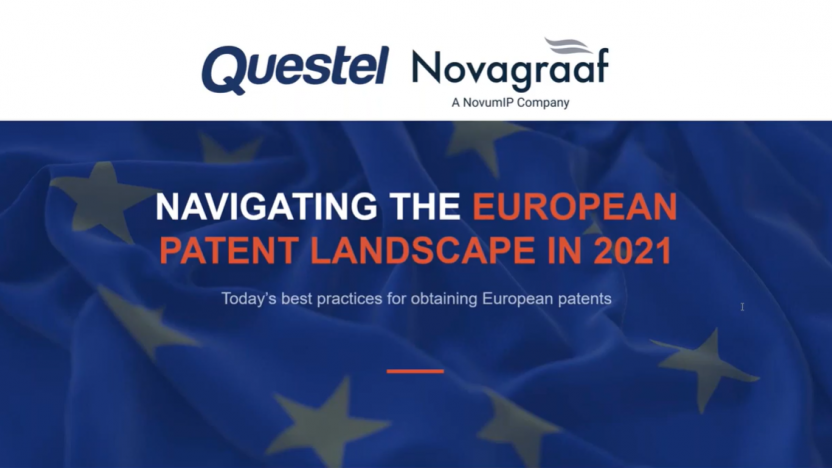Balancing quality and cost: A strategy for European patents


This is a summary of a recent webinar 'Navigating the European patent landscape in 2021'. Click here to watch the recording of the webinar in full
Preparation is key for companies looking to extend their patent rights via the European patent (EP) system. In a recent webinar, hosted by Questel, Novagraaf’s Marie-Noëlle de la Fouchardière, Managing Director – Patents in France, shared best practices for EP prosecution management. We summarise the key points from that presentation.
The EP system provides companies with an efficient structure for protecting inventions in Europe. However, there are a number of crucial points to consider if they are to make the best use of the system.
1. Avoiding priority pitfalls
The right of priority can cause issues for overseas applicants to the EP system. We have previously covered the ‘whole applicants’ requirement of the European Patent Office (EPO) in that respect. Another key requirement is that the priority application and the subsequent EP application are for the ‘same invention’ (A87, EPC). The EPO takes a strict approach to this, requiring that any claimed feature and any claimed combination be disclosed in the priority application. If it is not, the risk of losing the priority is high – and, if disclosure of the invention has taken place in the interim period, the EP application could also be refused on the basis of that prior art (A54, EPC).
2. Balancing claims and budgets
Understanding the claim format is critical for budget control in EP strategies, as adapting the claim set can limit additional fees and avoid unnecessary costs.
Additional fees become due for every claim beyond 15 claims in the EP system whereas multiple dependent claims can be used with no fee penalty. In addition, only one independent claim is allowed per category with only three allowable exceptions (R43, EPC). These are claims that cover: interrelated products (e.g. a transmitter and a receiver); different uses of a product; and, alternative solutions to a problem that cannot be covered in a single claim.
Careful consideration of how to structure claims, according to these parameters, can help avoid unnecessary costs, particularly:
- using multiple dependency; and
- selecting the independent claims to be prosecuted and removing multiple independent claims in the same category that do not fall into the list of permitted exceptions.
The claim set can be amended at the point of filing or, for those that enter via the PCT system, in response to the Written Opinion (WO) of the International Search Authority (ISA).
3. Navigating substantive examination
Applicants will typically receive one or more office actions (A94(3), EPC) once substantive examination begins, although it is possible that the examiner may jump directly to the allowance (R71(3), EPC) phase on the basis of a positive WO.
Where office actions are received, it is possible to file a main request and one or more auxiliary requests. Such auxiliary requests provide the opportunity to submit ‘fallback positions’ as they are examined sequentially and only if the higher-ranking requests have been refused. This enables applicants to avoid unnecessary limitations in their responses.
It is also common practice to file a conditional request for oral proceedings as a precautionary measure, as part of office action response. The objective being to avoid the examiner jumping directly to refusal without the applicant having a last chance to argue their case.
Oral proceedings are a two-step process, comprising a written submission and a hearing. A top tip here is to reach out to the examiner after filing the written submission, as if agreement can be found, the oral hearing will be cancelled. Note that these oral hearings now take place by video conference, as a result of COVID-19, which is also more cost-effective for applicants.
4. Amendments during prosecution
All amendments in the description or in the claims must be supported by the description.
This is a very strict requirement: any claimed combination shall be disclosed in the same combination in the specification as filed. It is of utmost importance, therefore, to include in the specification all the matters that may be needed down the road when the application is prosecuted.
Also, as we have previously covered, the EPO has recently strengthened its requirements to align the allowed claims and the description before the grant.
5. Expediting the EP grant procedure
For those who enter the EP process via the PCT system, it is possible to accelerate the procedure by waiving the invitation to respond to the WO (R161/162, EPC). The waiver will only be effective if the case is ready to move to the next phase of the EP procedure: this means that claim fees must be paid at entry into the national phase and, when the EPO is the ISA for the international application, the objections in the WO must be addressed.
A further way to speed up the EP application process is to file a request under the Program for Accelerated Prosecution of EP applications (PACE). This can be requested for individual EP applications once substantive examination has started and means that office actions will be received within shorter timeframes (typically less than three months).
Keep in mind, however, that extensions of time limits cannot be obtained under the PACE program. If you do request an extension, the benefit of the PACE program will be lost.
The Patent Prosecution Highway (PPH) provides another important route for both speeding up examination and saving cost. Under the PPH, an office of later examination can reuse the work product of an office of earlier application to accelerate processing. The application of earlier examination must have at least one allowable claim and the substantial examination of the application of later examination must not have begun. PPH provides consistent claims across countries.
Finally, gentle reminders to examiners as to the arrival of office actions is often an efficient way to reactivate stalled files.
For more detail on all the points discussed above, including a step-by-step guide to the EP search and examination process, please watch the recording of the webinar. You can also contact us for specific advice and tailored assistance on EP applications and the EP validation process.
Marie-Noëlle de la Fouchardière is Managing Director – Patents at Novagraaf in France.